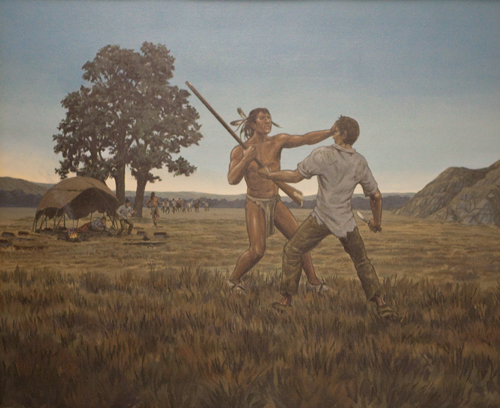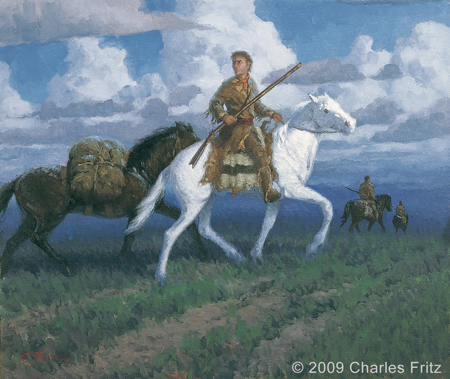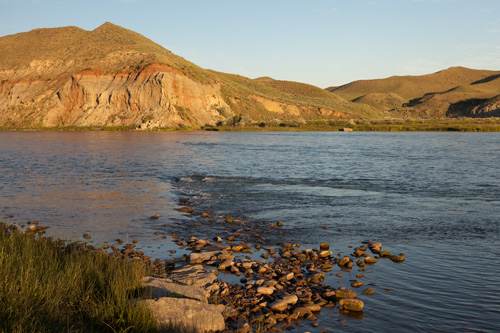On the Two Medicine River, the young Blackfeet camping with Lewis and his small party attempt to steal their rifles and horses. A fatal encounter ensues and everyone takes flight.
Clark and his group paddle through the Yellowstone Badlands passing large herds of bison and elk.
In the vicinity of Pompeys Pillar, Sgt. Pryor and his small group are stranded without horses. They decide to haul their gear to the Yellowstone River and make bull boats.
Below the Great Falls of the Missouri, Sgt. Gass and Pvt. Willard take the horses across the river and head towards the mouth of the Marias River. They camp on the Teton River.
Sgt. Ordway and the men remaining at Lower Portage Camp load the dugouts and white pirogue and paddle down the river the Missouri River.[1]For more on the captains’ strategy and various groups after leaving Travelers’ Rest, see Dividing Forces at Travelers’ Rest.
Violence on the Marias
by Yellowstone Public Radio[2]Originally aired weekdays by Yellowstone Public Radio during the Bicentennial observance of 2003-2006. Narrated by Hal Hansen. Scripts by Whit Hansen and Ed Jacobson. Produced by Leni Holliman. © … Continue reading
Fight with the Blackfeet (Lewis)
Four Guns Taken
This morning at day light the indians got up and crouded around the fire, J. Fields who was on post had carelessly laid his gun down behid him near where his brother was sleeping, one of the indians the fellow to whom I had given the medal last evening sliped behind him and took his gun and that of his brothers unperceived by him, at the same instant two others advanced and seized the guns of Drewyer and myself . . . .
—Meriwether Lewis
R. Field’s Fatal Response
R Fields as he seized his gun stabed the indian to the heart with his knife the fellow ran about 15 steps and fell dead . . . .
—Meriwether Lewis
Lewis’s Fatal Response
I pursued them so closely that they could not take twelve of their own horses but continued to drive one of mine with some others . . . . being nearly out of breath I could pursue no further, I called to them as I had done several times before that I would shoot them if they did not give me my horse and raised my gun, one of them jumped behind a rock and spoke to the other who turned around and stoped at the distance of 30 steps from me and I shot him through the belly . . . .
—Meriwether Lewis
One Last Shot
he fell to his knees and on his wright elbow from which position he partly raised himself up and fired at me, and turning himself about crawled in behind a rock which was a few feet from him. he overshot me, being bearheaded I felt the wind of his bullet very distinctly.
—Meriwether Lewis
Preparing to Leave
while the men were preparing the horses I put four sheilds and two bows and quivers of arrows which had been left on the fire, with sundry other articles; they left all their baggage at our mercy. they had but 2 guns and one of them they left the others were armed with bows and arrows and eyedaggs. the gun we took with us. I also retook the flagg but left the medal about the neck of the dead man that they might be informed who we were.
—Meriwether Lewis
Fleeing the Blackfeet Revenge
16″ x 19″ oil on canvas
© 2009 by Charles Fritz. Used by permission.
Taking Flight
having ascended the hill we took our course through a beatiful level plain a little to the S of East. my design was to hasten to the entrance of Maria’s river as quick as possible in the hope of meeting with the canoes and party at that place having no doubt but that they would pursue us with a large party . . . no time was therefore to be lost and we pushed our horses as hard as they would bear.
—Meriwether Lewis
Night Time Flight
we traveled untill 2 OCk in the morning having come by my estimate after dark about 20 ms. we now turned out our horses and laid ourselves down to rest in the plain very much fatiegued as may be readily conceived.
—Meriwether Lewis
The Yellowstone Badlands (Clark)
Graffiti
I marked my name with red paint on a Cotton tree near my Camp, and Set out at an early hour and proceeded on very well the river is much wider from 4 to 600 yards much divided by Islands and Sand bars
—William Clark
Numerous Buffalo and Elk
The Buffalow and Elk is estonishingly noumerous on the banks of the river on each Side, particularly the Elk which lay on almost every point in large gang and are So jintle that we frequently pass within 20 or 30 paces of them without their being the least alarmd.
—William Clark
Disappearing Mountains
when we pass the Big horn I take my leave of the view of the tremendious chain of Rocky Mountains white with Snow in view of which I have been Since the 1st of May last.
—William Clark
Hunting Report
about Sunset I Shot a very large fat buck elk from the Canoe near which I encamped, and was near being bit by a rattle Snake. Shields killed a Deer & a antilope [pronghorn] to day for the Skins which the party is in want of for Clothes.
—William Clark
Making Bull Boats (Pryor)
[They] packed up their baggage on their backs and Steared a N. E. course to the River Rochejhone which they Struck at pompys Tower, there they killed a Buffalow Bull and made a Canoe in the form and shape of the mandans & Ricares (the form of a bason) . . . .
—William Clark (recorded on 8 August 1806)[3]Sgt. Pryor was instructed to keep a journal, but no entries are known to exist. In Clark’s summary of Pryor’s trip, he condenses making packs, hiking to the Yellowstone, and making bull … Continue reading
Below Lower Portage Camp
© 1 July 2013 by Kristopher K. Townsend. Permission to use granted under the Creative Commons Attribution-Share Alike 4.0 International license.
Herding Horses (Gass and Willard)
In a fine clear pleasant morning, myself and one of the men [Alexander Willard] crossed the river with the horses, in order to go by land to the mouth of Maria’s river . . . . We then struck Tansy or Rose river, which we kept down about ten miles, and encamped.
—Patrick Gass
Steering the Pirogue and Dugouts (Ordway)
we halled out the white perogue out of the bushes and repaired hir. about 12 we loaded and Set out with the white perogue and the 5 canoes. procd. on down the rapid water fast.
—John Ordway
Weather Diaries
State of the weather at rise
Wind at rise
State of the weather at 4 P. M. Wind at 4 P. M. fair N W fair S W —Meriwether Lewis
State of the weather at Sun rise Wind at Sun rise State of the weather at 4 P. M Wind at 4 P M. fair N. E. fair S W. Saw a flight of gulls, a Small rattle Snake Several flocks of Crows & black burds.
—William Clark[4]To assist the reader of this web page, the date column is omitted and some abbreviations have been spelled out.
Two Medicine Fight Site is a High Potential Historic Site along the Lewis and Clark National Historic Trail managed by the U.S. National Park Service. The site is on private property.
Pompeys Pillar is a High Potential Historic Site along the Lewis and Clark National Historic Trail managed by the U.S. National Park Service. The site and interpretive center is managed by the U.S. Bureau of Land Management.
The Great Falls Portage is a High Potential Historic Site along the Lewis and Clark National Historic Trail managed by the U.S. National Park Service. It includes Sulpher Spring (open to the public) and lower portage camp site (private land), and the Upper Portage Camp Overlook.
Notes
| ↑1 | For more on the captains’ strategy and various groups after leaving Travelers’ Rest, see Dividing Forces at Travelers’ Rest. |
|---|---|
| ↑2 | Originally aired weekdays by Yellowstone Public Radio during the Bicentennial observance of 2003-2006. Narrated by Hal Hansen. Scripts by Whit Hansen and Ed Jacobson. Produced by Leni Holliman. © 2003 by Yellowstone Public Radio. |
| ↑3 | Sgt. Pryor was instructed to keep a journal, but no entries are known to exist. In Clark’s summary of Pryor’s trip, he condenses making packs, hiking to the Yellowstone, and making bull boats into a single sentence. Precise dates cannot be assigned. The hike alone likely consumed most of one day if not two. Before leaving, they would need to transfer the baggage from horse packs to makeshift backpacks, slings, and hand bags. If they camped near the place Interstate 90 crosses Fly Creek, the hike to Pompeys Pillar would be fifteen miles. Their baggage would have been heavy and awkward for the four men to carry such a distance. |
| ↑4 | To assist the reader of this web page, the date column is omitted and some abbreviations have been spelled out. |





